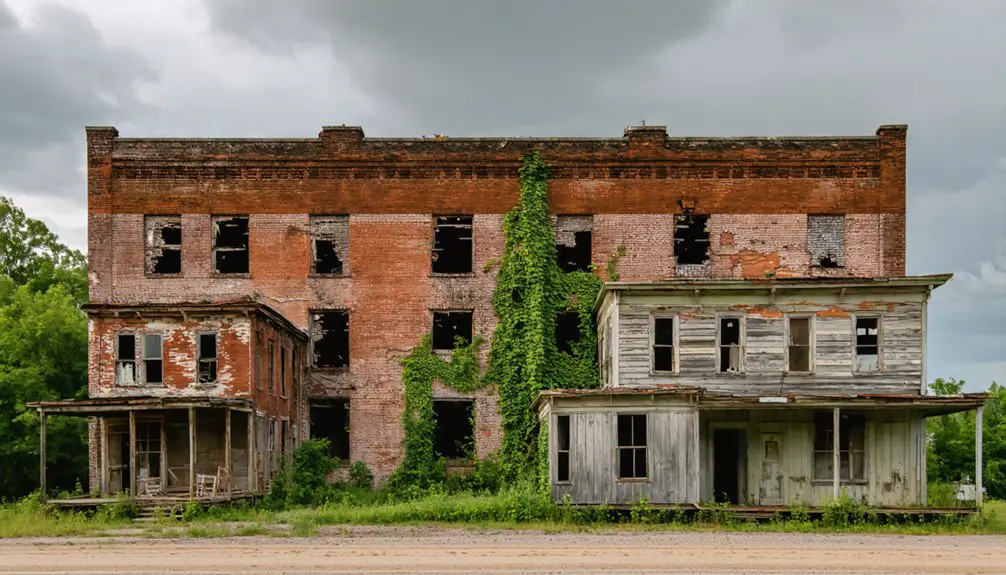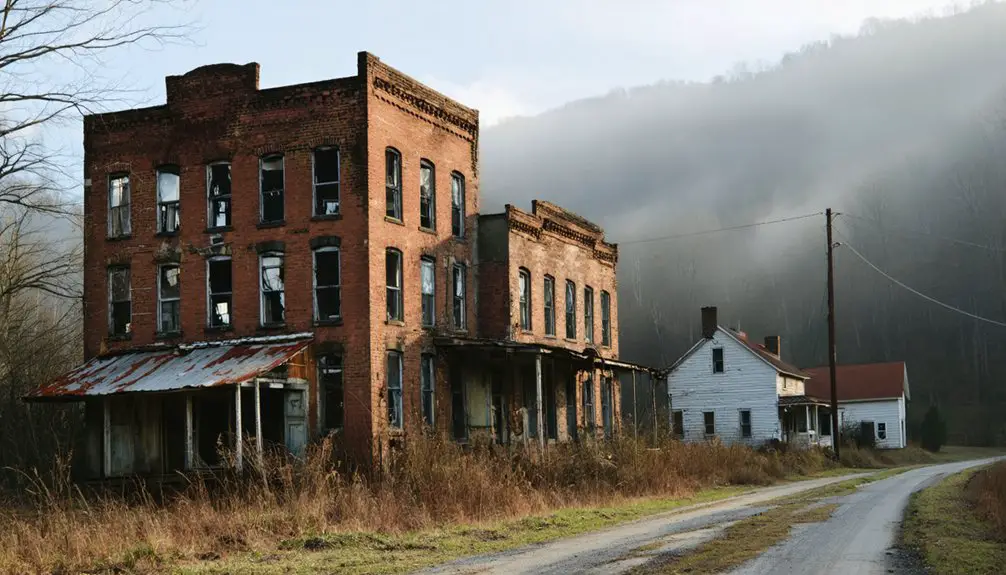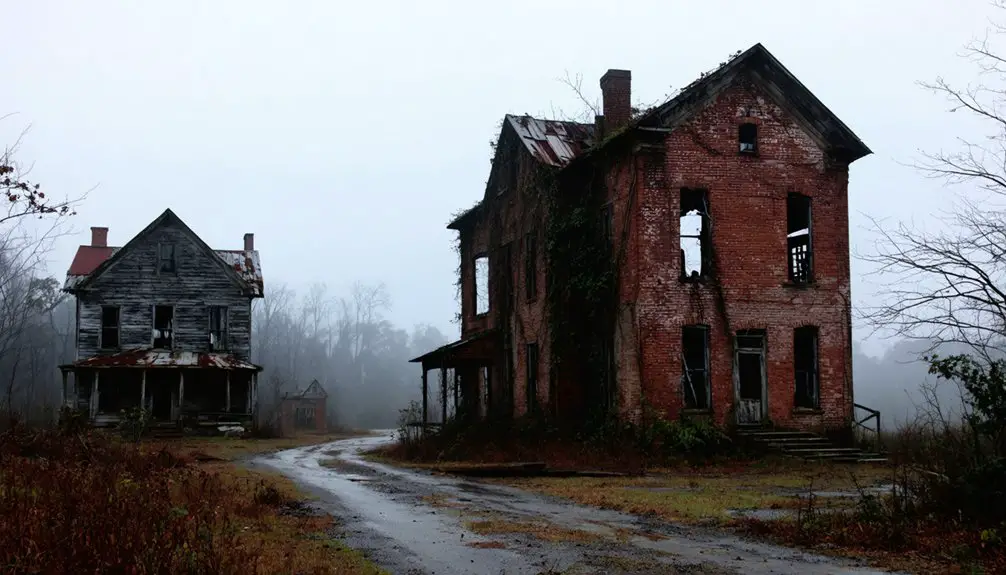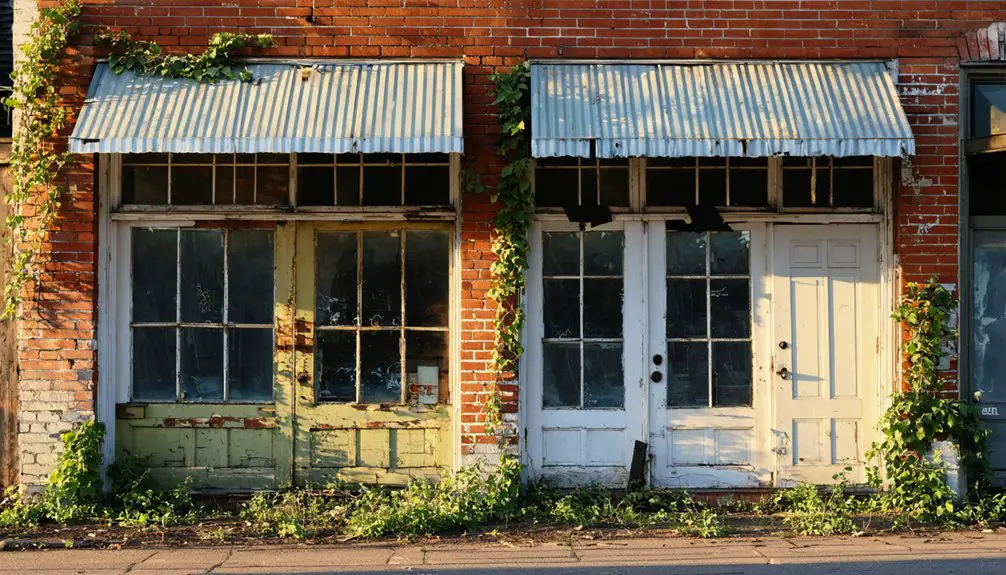You’ll find Henry River Mill Village, an abandoned textile community, nestled along the Henry River in Burke County, North Carolina. Established in 1904 by Michael Rudisill, the village grew around a cotton yarn mill powered by a 30-foot dam. The self-contained community featured 35 worker cottages, a company store, and thrived until the 1960s when operations ceased. While many structures deteriorated, about 20 historic cottages still stand today, offering glimpses into early 20th-century mill life.
Key Takeaways
- Henry River Mill Village was established in 1904 as a textile manufacturing community before becoming abandoned in the late 1960s.
- The site features remnants of 20 worker cottages, a large brick company store, and a 30-foot concrete dam.
- The village gained fame as a filming location for “The Hunger Games” movie after its abandonment.
- New ownership since 2017 is transforming the ghost town into a tourist destination with vacation rentals and guided tours.
- The historic site earned National Register of Historic Places status in 2019, preserving 72 acres of industrial heritage.
The Birth of a Mill Village (1905)
In 1904, Michael Erastus Rudisill established what would become the Henry River Mill Village on a strategic 1,500-acre tract in Burke County, North Carolina. The founding significance of this location near Hildebran and Interstate 40’s current exit 119 lay in its hydropower potential along the Henry River’s small gorge.
Through meticulous community planning, the Henry River Manufacturing Company incorporated in 1905, constructing a 30-foot reinforced concrete dam and three-story brick mill building. The mill specialized in producing fine cotton yarns for textile manufacturing. Local families like the Aderholdts and Rudisills played key roles in founding the manufacturing company.
You’ll find the village was designed as a complete industrial complex, featuring about 35 worker cottages, a two-story boarding house, and a brick company store. The self-contained community included essential infrastructure like water systems, fire protection, and a bridge, all positioned to harness the river’s natural power for industrial operations.
Water-Powered Innovation and Industrial Growth
From its inception, the Henry River Manufacturing Company‘s success hinged on harnessing the river’s natural power. The mill’s water innovation began with a 30-foot concrete dam built in 1905, powering 4,000 spindles through mechanical turbines.
Harnessing the Henry River’s flow, a pioneering 30-foot dam transformed raw water power into industrial might for thousands of spinning machines.
You’ll find that this renewable energy source wasn’t just for manufacturing – it supplied the entire village’s water needs and fire protection. The village’s community relied on the company store for all their basic necessities.
As industrial expansion took hold, the mill evolved beyond water power. Steam engines arrived in 1914, followed by electric power in 1926. The company invested $90,000 to complete the transition to electric power.
These upgrades drove production skyward, with spindle capacity reaching 10,300 by the 1940s. You could see weekly output soar to 15,000 pounds of specialized yarns used in lace, gloves, and electrical insulation.
Life in a Company-Owned Community
If you’d lived in the Henry River mill village, your daily routines would have centered around the two-story brick company store, where workers purchased supplies and gathered for social activities.
You’d have likely attended church services or school classes in the store’s upper floor between 1907-1917, as it served multiple community functions beyond retail.
The store’s prominent role in village life reflected the company’s economic control, where workers depended on mill employment for both their wages and access to essential goods and services.
Workers could only make purchases using special doogaloo coins issued by the company as payment for their labor.
The village grew steadily as production expanded from 4,000 spindles in 1905 to meet increasing manufacturing demands.
Company Store Economics
Life in Henry River’s company-owned community revolved around its centrally-located company store, which served as both an economic hub and a mechanism of control.
You’d find yourself trapped in a system of economic dependency, where your wages came in scrip currency – only redeemable at the company store. With inflated prices and limited consumer choices, you couldn’t escape this exploitative practice.
The store’s monopoly meant you’d pay more for basic necessities while the company maintained social control through your financial reliance. The store operated based on the British truck system where workers exchanged their labor directly for goods rather than wages. These stores emerged prominently during the Industrial Revolution when coal mining transformed Appalachia.
Though the store fostered community cohesion as a gathering place, it simultaneously enabled wage exploitation.
Despite the store’s role in providing essential goods and services, it represented a system that sparked labor resistance, as workers fought against their forced patronage of this controlling institution.
Daily Village Routines
While the textile mill’s whistle signaled the start of each workday in Henry River Mill Village, your daily routine would begin well before dawn.
You’d wake up in your company-owned house, tend to basic needs using the outhouse, and prepare for a long shift at the mill. Without modern plumbing, you’d haul water for cooking and washing.
Between shifts, you’d find yourself engaged in village interactions at the company store, where you’d purchase necessities, collect mail, and exchange news with neighbors. The brick two-story store served as the heart of community life.
Daily chores would consume your evenings – maintaining your home, caring for family, and perhaps attending church services or school in the store’s upper floor.
The tight-knit community would provide support through shared hardships, creating bonds strengthened by common experiences in this isolated mill town. With over 300 residents living in close quarters, neighbors became like extended family members.
Architecture and Infrastructure
Today, you’ll find the remnants of Henry River’s industrial heritage in its three-story brick mill building foundations and the 30-foot reinforced concrete dam constructed in 1905.
The village’s worker housing consisted of about 35 small 1.5-story duplex cottages, with approximately 20 still standing along the steep northern bank of the Henry River.
The mill’s hydropower system utilized the dam and water wheels to power the machinery, while the worker cottages were built without running water or modern utilities, relying instead on outhouses for sanitation.
Mill Construction Materials
The Henry River Mill’s construction relied heavily on locally sourced materials, combining river rock foundations with sun-baked mud bricks harvested from nearby riverbanks.
These traditional mill building techniques provided remarkable durability, with the chalky bricks withstanding over a century of severe weather events.
You’ll find the mill’s structural framework followed early 20th-century design principles, utilizing timber framing throughout the upper portions.
This smart combination of rock foundations and wooden superstructures protected against flooding while maximizing local material usage.
The builders paired these elements with wooden siding and clapboard to enhance weather resistance.
The result was a resilient industrial complex that, despite its simple materials, stood the test of time and demonstrated the effectiveness of regionally-sourced construction methods.
Village Housing Design
Situated near the central mill building, Henry River’s worker housing consisted of roughly 35 wooden dwellings designed for high-density living in the early 1900s.
You’ll find these houses packed closely together, minimizing workers’ commute times to the mill. The modest structures typically housed two families each, featuring concrete porches but no indoor plumbing.
The worker housing reflects the utilitarian needs of the era, with basic wooden construction and century-old floorboards. While time has weathered these dwellings, current architectural preservation efforts maintain their historical authenticity.
Since 2017, private owners have carefully restored select houses, like house #12, balancing modern amenities with original features.
The village layout included essential community buildings like boarding houses and the company store, creating a self-contained mill community.
Industrial Power Systems
When Henry River Manufacturing Company began operations in 1905, its industrial power system relied on a reinforced concrete dam harnessing the Henry River’s waterpower.
You’ll find this dam wasn’t just for power generation – it also supported the village’s fire protection and water supply systems.
The mill’s energy shifts marked distinct phases in its technological evolution. You can trace its power innovations from waterpower through 1914, then to steam power, and finally to electricity by 1926.
These upgrades revolutionized production capacity, allowing the mill to expand from 4,000 spindles to an impressive 12,000 by the 1960s.
As one of the region’s last water-powered cotton mills, Henry River’s power systems showcase the rapid industrial advancement that transformed Southern manufacturing in the early 20th century.
The Golden Age of Textile Manufacturing
North Carolina’s rise to textile manufacturing dominance emerged from a perfect confluence of natural advantages and economic factors in the early 1800s.
You’ll find that the state’s mild climate enabled year-round production, while abundant waterpower from rivers drove the first mills along the Atlantic Fall Line.
Textile innovation accelerated when steam power arrived in 1834, freeing mills to expand beyond waterways.
From Prosperity to Abandonment

Despite its earlier prosperity, Henry River’s textile mill operations ground to a halt in the late 1960s as overseas competition devastated the American textile industry.
Even though production had tripled from 1905 levels by 1963, mounting economic challenges proved insurmountable. The shift from waterpower to steam and electric power only delayed the inevitable decline.
Despite modernization efforts and increased production, market forces ultimately sealed the fate of Henry River’s once-thriving textile operations.
Once the mill closed, you’d have witnessed a rapid community decline as families departed, leaving behind empty homes and shuttered businesses.
The village’s extensive infrastructure – from the company store to the church and school – fell silent.
By the 1970s, nature began reclaiming the abandoned structures, and a 1977 lightning strike sparked a fire that further damaged the ghost town.
The once-bustling mill village had transformed into a hollow shell of its former glory.
Hollywood Comes to Henry River
The film tourism boom following the movie’s release has sparked:
- Overnight stays in restored mill houses modeled after movie sets
- Guided tours highlighting both film locations and village history
- Special events celebrating the site’s Hollywood connection
Since 2017, new owners have capitalized on this fame by restoring buildings for tourism, including vacation rentals and a planned restaurant.
The village’s value soared beyond $1.2 million as its film legacy continues drawing fans to experience this piece of Hollywood in North Carolina.
Preservation and Historical Recognition

Since gaining National Register of Historic Places status in May 2019, Henry River Mill Village stands as a protected tribute to Burke County’s industrial heritage.
Henry River Mill Village preserves Burke County’s industrial legacy, earning its rightful place on the National Register of Historic Places.
The historic district designation covers 72 acres, including the company store, mill houses, reservoir, and support buildings, emphasizing its historical significance as a self-contained industrial community.
You’ll find preservation efforts in full swing under Henry River Mill Village LLC’s ownership since 2017.
They’re converting original homes into vacation rentals while planning a restaurant and museum.
Despite preservation challenges like decades of decay and the 1977 mill fire, the village maintains its role as a rare example of early 20th-century textile mill life.
Through guided tours and special events, you can experience this unique piece of Western North Carolina’s past, complete with stories of “doogaloos” and mill worker life.
Exploring the Ghost Town Today
Modern-day visitors exploring Henry River Mill Village will find this historic site 75 miles east of Asheville, North Carolina, just off I-40’s Exit 119.
While ghost stories and local legends surround the abandoned structures, you’ll discover a village that’s slowly coming back to life. The 72-acre property offers several ways to experience its unique atmosphere:
- Take guided tours through the historic district, including the company store made famous as Mellark’s Bakery in “The Hunger Games”
- Book an overnight stay in one of the restored mill houses, now converted into vacation rentals
- Visit House 16’s museum to explore artifacts and learn about the village’s rich history
You can view much of the village from Henry River Road, but special events and tours provide the best access to this fascinating ghost town.
Frequently Asked Questions
What Happened to the Original Mill Families After the Village Closed?
Like scattered seeds, mill family livelihoods were uprooted when you’d see them leave their homes behind. They migrated to nearby North Carolina towns, seeking new work as their tight-knit community dispersed.
Are There Any Burial Grounds or Cemeteries Within the Village?
You won’t find any documented burial grounds or cemeteries within Henry River Mill Village itself. The burial history and cemetery locations of mill families were likely established at sites outside the village boundaries.
How Much Did Workers Earn During the Mill’s Peak Operations?
You’d find workers earned low wages typical of Southern cotton mills, with their economic impact further diminished by the scrip payment system that forced them to shop at company stores.
Did Any Supernatural Legends or Ghost Stories Emerge From the Village?
You’ll discover haunted tales of objects thrown from empty houses, mysterious voices near the dam, and spectral sightings in the Company Store. Children’s voices calling “Sarah” and “Emily” echo through the village.
What Traditional Crafts or Skills Were Passed Down Through Mill Families?
You’d learn weaving techniques and textile skills from your parents, alongside woodworking skills for home repairs, food preservation methods, and household crafts like sewing and knitting for daily necessities.
References
- https://appalachianhistorian.org/repurposed-appalachia-the-rise-fall-and-revival-of-henry-river-mill-village/
- https://henryrivermillvillage.com/history/
- https://roadtrippers.com/magazine/henry-mill-river-hunger-games-district-12/
- https://www.romanticasheville.com/henry-river
- https://www.youtube.com/watch?v=0Cxg-0Bc7Os
- https://forsythfamilymagazine.com/henry-river-mill-village-a-lost-town-coming-back-to-life/
- https://en.wikipedia.org/wiki/Henry_River_Mill_Village
- https://www.artofabandonment.com/2022/03/henry-river-mill-village-the-hunger-games-district-12-hickory-nc/
- http://americanurbex.com/wordpress/?p=2776
- https://trailertravelsblog.wordpress.com/2020/05/06/hickory-and-henry-river-village-north-carolina/



